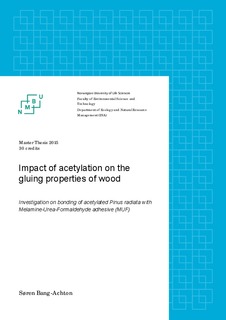| dc.contributor.author | Bang-Achton, Søren | |
| dc.date.accessioned | 2015-11-04T08:42:33Z | |
| dc.date.available | 2015-11-04T08:42:33Z | |
| dc.date.copyright | 2015 | |
| dc.date.issued | 2015-11-04 | |
| dc.identifier.uri | http://hdl.handle.net/11250/2359188 | |
| dc.description | Investigation of factors affecting bonding properties of chemically modified Radiata pine with melamine-urea-formaldehyde adhesive (MUF) Prefere 4546/5022 produced by Dynea AS for load bearing constructions. | nb_NO |
| dc.description.abstract | Modified wood and the wood industry have a big potential in the future due to a growing global concern for non-environmental friendly chemicals and increasing focus on sustainability. The main purpose to modify wood is to increase the naturally durability of the wood and the ASE. One of the market’s leading chemical wood modification methods is acetylation of wood. Acetylation of wood has showed to affect the bonding properties of several adhesives. Today there is no existing MUF adhesive system which can bond acetylated wood in service class 3. Development of a MUF adhesive system capable of bonding acetylated wood in services class 3 can have a positive impact throughout the value chain. The objective of this thesis was to increase the understanding of the interaction between MUF adhesive and acetylated wood. Rheology measurements of MUF adhesive directly on wood surfaces of acetylated and untreated wood have been made, as well as contact angle measurements, pH and buffer capacity determinations. Microscope analyses of the adhesive bond line and penetration in Radiata pine (Pinus radiata D. Don) have been made under fluorescence and normal light. Rheology analysis showed a lower increment in the complex viscosity for the tested MUF adhesive during the first three minutes on acetylated Radiata pine compared with untreated. No clear differences were seen in the microscope analyses except of a clear lack of adhesion between the cured MUF bulk adhesive and acetylated cell wall. As expected, a lower pH was found in acetylated wood; lowest in the core of the planks and higher in the outer part. Higher contact angle was found and thus poorer wetting properties of the acetylated wood in relation to the untreated wood. Furthermore, untreated wood did not show any alkaline buffer capacity in contrast to the acetylated wood. | nb_NO |
| dc.description.sponsorship | Dynea AS,
Norwegian Institute of Bioeconomy Research (NIBIO),
Norwegian Research Council | nb_NO |
| dc.language.iso | eng | nb_NO |
| dc.publisher | Norwegian University of Life Sciences, Ås | |
| dc.rights | Navngivelse 3.0 Norge | * |
| dc.rights.uri | http://creativecommons.org/licenses/by/3.0/no/ | * |
| dc.subject | Chemical wood modification | nb_NO |
| dc.subject | Acetylation | nb_NO |
| dc.subject | Melamine Urea Formaldehyde adhesive (MUF) | nb_NO |
| dc.subject | Gluing | nb_NO |
| dc.subject | Rheology | nb_NO |
| dc.subject | Rheometer | nb_NO |
| dc.subject | Contact angle | nb_NO |
| dc.subject | pH | nb_NO |
| dc.subject | Buffer capacity | nb_NO |
| dc.subject | Microscopy analysis | nb_NO |
| dc.subject | Adhesive penetration | nb_NO |
| dc.subject | Pinus radiata D. Don | nb_NO |
| dc.title | Impact of acetylation on the gluing properties of wood | nb_NO |
| dc.type | Master thesis | nb_NO |
| dc.subject.nsi | VDP::Agriculture and fishery disciplines: 900::Agriculture disciplines: 910::Forestry: 915 | nb_NO |
| dc.subject.nsi | VDP::Technology: 500::Materials science and engineering: 520::Building materials: 525 | nb_NO |
| dc.subject.nsi | Wood technology | nb_NO |
| dc.source.pagenumber | 88 | nb_NO |
| dc.description.localcode | M-SF | nb_NO |

